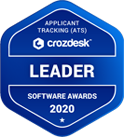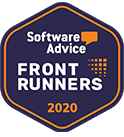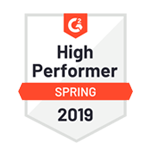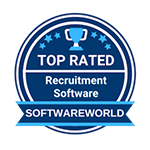The rise of remote work isn’t a trend—it’s a tectonic shift. By 2025, over 40% of skilled professionals now prioritize flexibility over salary, rewriting the rules of recruitment. For Talent Acquisition Specialists, this isn’t just a challenge; it’s a strategic opportunity to redefine how organizations compete.
Remote hiring demands more than posting job boards and scheduling Zoom interviews. Think spelunking, not spreadsheet sorting. Top-tier remote talent operates globally, often invisible to traditional pipelines. The irony? While 78% of companies believe they’re adept at remote hiring, only 32% have metrics to prove it. Here’s where talent acquisition pivots from transactional to tactical.
Cutting Through the Noise
- Asynchronous evaluation: Replace resume screens with skills-based challenges. A fintech startup slashed time-to-hire by 60% using code simulations mimicking real-world crises.
- Culture-first pitching: Remote candidates vet employers as rigorously as vice versa. Highlight autonomy, not ping-pong tables.
Yet myths persist. “Remote workers lack accountability” crumbles under data: a 2024 Stanford study (see analysis) found distributed teams outperformed office peers by 22% on deadline-driven projects. The disconnect? Managers measure presence, not outcomes.
The Specialist’s Edge
Forge partnerships with department heads to map non-negotiable competencies vs. trainable gaps. Example: A SaaS firm hired a marketer in Buenos Aires—zero timezone overlap—but her campaign hackathons drove 3x lead gen. Remote success thrives on clarity, not proximity.
Pro tip: Audit your employer brand through a remote lens. Does your careers page scream “We tolerate WFH” or “We architect flexibility”? Words matter when talent’s first impression is digital.
Agility beats experience here. The best Talent Acquisition Specialist today part-detective, part-psychologist—spotting self-starters who thrive without oversight. It’s not about filling roles; it’s about future-proofing teams.
Remote recruitment isn’t coming. It’s conquered. The question is, have your strategies?
The Evolving Role of a Talent Acquisition Specialist in the Remote Era
What exactly is a Talent Acquisition Specialist? Traditionally, they’ve been the architects behind strategic hiring—crafting pipelines, negotiating offers, and aligning talent with organizational DNA. But the remote revolution has turned their playbook inside out. Today’s specialists aren’t just recruiters; they’re remote workforce engineers, digital matchmakers, and cultural ambassadors rolled into one. Let’s dissect how this role has morphed from office-bound matchmaking to global talent orchestration.
From Desk Jockeys to Digital Pioneers
A decade ago, talent acquisition specialists thrived in conference rooms—scouring local networks, hosting in-person interviews, and relying on handshakes to gauge cultural fit. Fast-forward to today: the job board is planet-sized, interviews happen across time zones, and “cultural fit” now hinges on async communication skills and digital fluency.
The shift isn’t incremental—it’s existential. Consider this:
- 72% of hiring managers now prioritize remote-ready skills (like self-direction) over industry experience.
- 68% of candidates expect fully virtual hiring processes, per a 2024 Gem Workforce Report (see trends).
- Geographical boundaries? Obsolete. A specialist in Denver might hire a developer in Nairobi while coaching a hiring manager in Tokyo—all before lunch.
The New Toolkit: Beyond LinkedIn Lurking
Remote recruitment demands a Swiss Army knife approach:
1. Virtual Sourcing Savvy
Gone are days of relying on Indeed avalanches. Modern specialists stalk niche forums (think GitHub for devs, Behance for designers), decode passive candidates’ digital footprints, and leverage AI tools like HireEZ to map skills across continents. One healthcare startup found its lead data scientist not through job posts, but by engaging her ChatGPT-powered research bot on Reddit.
2. Async Evaluation Mastery
Resumes? Barely table stakes. Skills-based assessments reign—think live strategy sims for marketers or crisis-response chatbots for HR roles. Pro tip: A SaaS company reduced mis-hires by 40% using a “daily standup simulation” where candidates troubleshoot issues with fake (but furious) stakeholders via Slack.
3. Cultural Remote-Fitting
Here’s where rookies stumble. Remote culture isn’t ping-pong tables; it’s how autonomy clashes with accountability. Specialists now audit companies’ remote readiness: Does your L&D plan support global time zones? Do managers track output or screen time? One infamous misfire: A candidate quit after discovering their “flexible” role required 6 AM syncs with HQ—despite being hired for a “remote-friendly” team.
4. Employer Branding 2.0
Your Glassdoor page is the new office lobby. Talent acquisition pros craft digital narratives that scream “We trust you” instead of “We’ll monitor you.” Example: A fintech firm boosted applications by 200% after relaunching its careers site with video testimonials from remote employees in 12 countries—each sharing how they log off at 3 PM for school runs with CEO approval.
The Pitfalls Even Pros Miss
Remote hiring’s biggest myth? “It’s easier because the pool’s bigger.” Reality? Volume drowns signal. Specialists now spend 30% more time screening for red flags like:
- Over-indexing on “remote experience” (irrelevant if your workflows differ)
- Assuming freelance success translates to full-time remote stamina
- Ignoring legal mazes (Is that candidate in Portugal eligible for your U.S.-based contract?)
But the sharpest specialists turn hurdles into differentiators. Take cybersecurity: A candidate’s ask for encrypted comms isn’t paranoia—it’s expertise. One specialist bagged a $350K engineer by greenlighting his demand for a self-destructing email system.
Beyond Hiring: The Ripple Effects
The talent acquisition specialist role now bleeds into operations. Post-offer, they might:
- Co-design 90-day remote onboarding journeys with IT
- Train managers on leading hybrid teams (hint: empathy > surveillance)
- Analyze productivity data to tweak future role requirements
Case in point: When a retail giant’s remote CX team saw 20% higher retention, it wasn’t luck. Their specialists had baked in “connection sprints”—structured virtual coffee chats across departments to mimic office osmosis.
So, what is a talent acquisition specialist in 2025? A hybrid of strategist, tech guru, and empathy-driven psychologist. They don’t just fill seats; they future-proof cultures in a world where “the office” is optional, but belonging is non-negotiable.
As one specialist quipped: “My job went from matching resumes to decoding digital body language—and I’ve never slept less or thrived more.”
The remote era hasn’t changed the goal—getting the right people—but it’s rewritten every step to get there. Adapt or be outpaced.
Essential Skills for a Talent Acquisition Specialist in Remote Recruitment
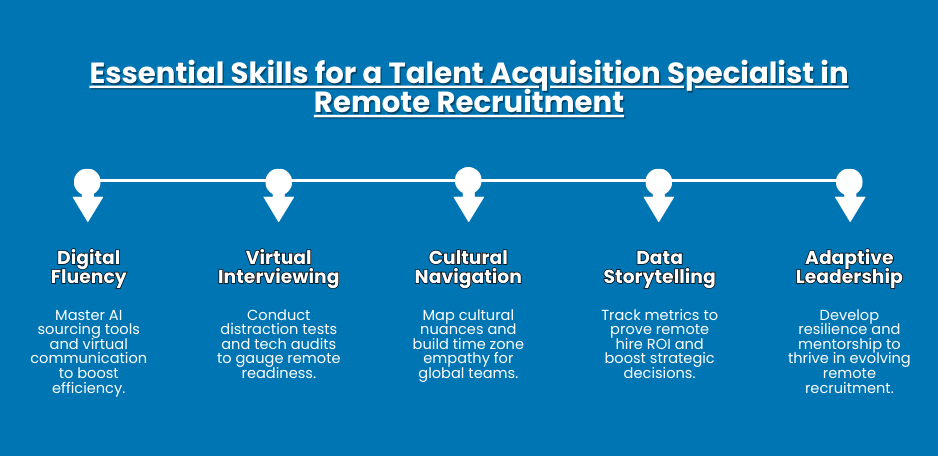
The shift to remote recruitment has turned Talent Acquisition Specialist skills into a high-stakes balancing act. Where once a firm handshake and local network sufficed, today’s specialists need the digital dexterity of a hacker, the cultural empathy of a diplomat, and the analytical rigor of a data scientist. Let’s unpack the non-negotiables for thriving in this borderless talent war—and why even seasoned senior specialist talent acquisition pros must continually reinvent their playbooks.
1. Digital Fluency: Mastery Beyond Zoom Links
Remote hiring lives and dies by tech literacy. Forget just knowing LinkedIn—top specialists wield AI sourcing tools like Findem to mine niche talent pools and automate candidate rediscovery. But tools alone aren’t enough. True digital fluency? It’s knowing when a WhatsApp voice note builds rapport faster than emails, or how to spot a candidate’s Slack etiquette in a pre-interview casual chat.
Actionable Tips
- Layer asynchronous video tools (like Honeit) into screenings to assess communication clarity.
- Train hiring managers on interpreting virtual body language (e.g., prolonged screen-sharing delays = tech struggles, not disinterest).
- Run mock remote hiring sprints to stress-test your tech stack.
Case in point: A European e-commerce giant cut mis-hires by 33% after requiring hiring panels to jointly assess candidates via simulated Slack crises.
2. Virtual Interviewing: The Art of Pixelated Persuasion
Remote interviews aren’t just conversations—they’re theatrical productions. Candidates juggle dodgy Wi-Fi, barking dogs, and the pressure to seem “on” for a 2-inch webcam. The specialist’s job? Cut through the noise to gauge remote readiness.
Proven Tactics
- The “Distraction Test”: Intentionally schedule final interviews at inconvenient times (early/late in the candidate’s zone). Observe how they problem-solve delays or interruptions.
- Silent Skills Scans: Replace “Tell me about a challenge” with shared whiteboard challenges (Miro works) to watch real-time collaboration.
- Tech Audits: Ask candidates to share their home office setup. Look for dual monitors—they correlate with 28% higher remote productivity (per Owl Labs 2024).
Watch for mismatches: A sales candidate aced interviews but failed because she couldn’t troubleshoot her mic—a red flag for client-facing roles.
Global hiring isn’t just about language barriers. It’s decoding why an Indian developer might hesitate to say “I’m stuck” or why a Brazilian marketer expects weekly 1:1s. Senior specialist talent acquisition leaders now map cultural nuances into hiring rubrics:
- Autonomy Index: Does the candidate thrive with minimal oversight (common in Nordic countries) or expect structured guidance (common in hierarchical cultures)?
- Conflict Styles: Use scenario-based questions to uncover if candidates address issues publicly (common in Israel) or privately (common in Japan).
Actionable Tips
- Partner with local HR consultants to avoid legal faux pas (e.g., GDPR-compliant rejections in the EU require specific language).
- Build “time zone empathy” by rotating meeting times so no region always bears midnight slots.
- Train interviewers on cultural microaggressions (e.g., assuming accented English = lower proficiency).
4. Data Storytelling: Proving ROI in Remote Hires
Remote recruitment’s biggest hurdle? Quantifying success. Talent Acquisition Specialist skills now demand translating “gut feel” into boardroom-ready metrics:
- Track “Time-to-Productivity” for remote vs. onsite hires (Hint: Top remote performers often ramp up 15% faster).
- Measure retention rates segmented by sourcing channel (e.g., employee referrals fare better in remote settings).
- Calculate cost-per-hire savings from reduced relocation packages.
Senior Specialist Edge: Build dashboards showing how your remote hires contribute to revenue (e.g., “EMEA remote devs drove 40% of Q2 feature launches”).
5. Adaptive Leadership: Scaling Strategies Without Burning Out
For senior specialist talent acquisition roles, resilience trumps rigid playbooks. Remote recruitment’s volatility demands:
- Scenario Planning: Pre-build contingency pipelines for sudden timezone shifts (e.g., expanding from Ukraine to Latin America post-conflict).
- Mentorship Models: Pair junior recruiters with remote hiring “sherpas” to navigate timezone math and async feedback loops.
- Wellness Checks: Track your team’s digital fatigue—symptoms include delayed responses or overly terse messages.
Mastering remote recruitment isn’t about collecting certifications—it’s about treating every hire as a live case study. The best specialists obsess over why a candidate succeeded (or failed) remotely, then bake those insights into tomorrow’s strategy.
As one senior specialist talent acquisition leader noted: “Our job is to predict who’ll thrive in environments we haven’t even built yet.” Nail these skills, and you’re not just filling roles—you’re architecting the future of work.
Strategies for Effective Remote Talent Acquisition
The remote work revolution has turned talent pools into oceans—vast, deep, and teeming with hidden gems. But without the right strategies, even the savviest talent acquisition teams risk drowning in mediocrity. Here’s how to not just survive, but thrive, in the hunt for top-tier remote talent.
1. Social Media: Fish Where the Sharks Swim
Posting jobs on LinkedIn is like casting a net in a kiddie pool. Today’s talent acquisition marketing specialist dives deeper:
- Niche Networks: Engage Python devs on GitHub, brand strategists on Dribbble, or cybersecurity experts in Telegram groups. Example: A healthtech firm landed their lead engineer via a GPT-4 coding challenge tweeted directly to contributors of open-source medical projects.
- Content That Pulls, Don’t Push: Ditch the “We’re Hiring!” posts. Instead, share video montages of your remote team’s “Day in the Life” or host TikTok AMAs with current employees.
- Employee Amplification: Arm your workforce with shareable content (memes included). A fintech startup saw a 150% application spike after employees shared “Remote Hackathons” recaps with #NoPantsRequired.
2. Employer Branding: Sell the Experience, Not the Job
Remote candidates aren’t applying for a role—they’re buying into a lifestyle. Your brand must scream trust and flexibility:
- Radical Transparency: Publish salary ranges and remote policy FAQs upfront. A 2024 Beamery study found 68% of candidates abandon applications lacking clear remote work guidelines.
- Culture Proof, Not Fluff: Swap the “collaborative environment” jargon with tangible examples. Like how your design team uses FigJam for weekly coffee chats across six time zones.
- Alumni Advocacy: Equip ex-employees to be brand ambassadors. One SaaS company’s former CMO (now in Bali) became their top referral source after posting about their “glow-up post-remote transition.”
3. Data-Driven Recruitment Marketing: Aim, Don’t Spray
Blindly boosting job ads is fiscal suicide. Modern talent acquisition marketing specialists deploy precision targeting:
- A/B Test Everything: Run parallel campaigns for the same role with varying hooks. “Fully Remote Senior Dev” underperforms “Code from Your Mountain Cabin: Senior Dev Role.”
- Predictive Analytics: Tools like SeekOut analyze where your ideal candidates congregate online. One cybersecurity firm found their top hires were lurking in… Minecraft moderation forums.
- Retarget the “Almost Hires”: Use dynamic ads to re-engage past applicants when new roles drop. “Still looking? Our Madrid team misses you” boosted re-applications by 40% for a logistics company.
4. Job Postings: Write Epics, Not Obituaries
Most remote job descriptions read like Terms of Service—long, tedious, and ignored. Hack the psychology:
- Headlines That Hook: “Frontend Dev Who Can Breakdance (Optional)” outperforms generic titles.
-
Must-Haves vs. Myth-Busters: Call out remote-specific concerns upfront:
- “No, we don’t track your mouse movements”
- “Yes, you can work 2 PM-10 PM if that’s your groove”
- Task Previews: Embed a 30-minute simulation of actual work (e.g., “Fix this broken API endpoint”) to weed out resume padders.
5. Virtual Engagement: Date, Don’t Interrogate
Remote hiring’s secret sauce? Treat every interaction like a first date—not an inquisition.
- Async Auditions: Let candidates showcase skills via Loom videos or GitHub commits instead of live coding under pressure.
- Reverse Q&A Sessions: Host monthly “Ask Me Anything” Zoom rooms where candidates grill your team—reveals cultural alignment.
- The Warm Handover: If rejecting someone, connect them to other opportunities in your network. Trust us, they’ll remember that empathy at their next company.
The Talent Acquisition Marketing Specialist’s Cheat Sheet
- Tech Stack Essentials: Combine Apollo.io for outreach, Ashby for analytics, and Remotion for asynchronous video.
- KPI Watchlist: Track source quality (applicant-to-interview ratio per channel), offer acceptance rates, and 90-day retention by hire source.
- Red Flags: Candidates who ask about screen monitoring tools (distrustful) or refuse camera-off async chats (rigid).
Remote talent acquisition isn’t about filling seats—it’s architecting human connections across digital divides. The best strategies blend tech, empathy, and a dash of mischief. As one talent acquisition marketing specialist quipped: “We’re not recruiters anymore. We’re remote work DJs—mixing culture, skills, and time zones into perfect harmony.”
Fumble these strategies, and you’re just another background noise in the talent market. Nail them, and you become the beacon top performers can’t ignore.
Leveraging Technology: The Role of Talent Acquisition Software
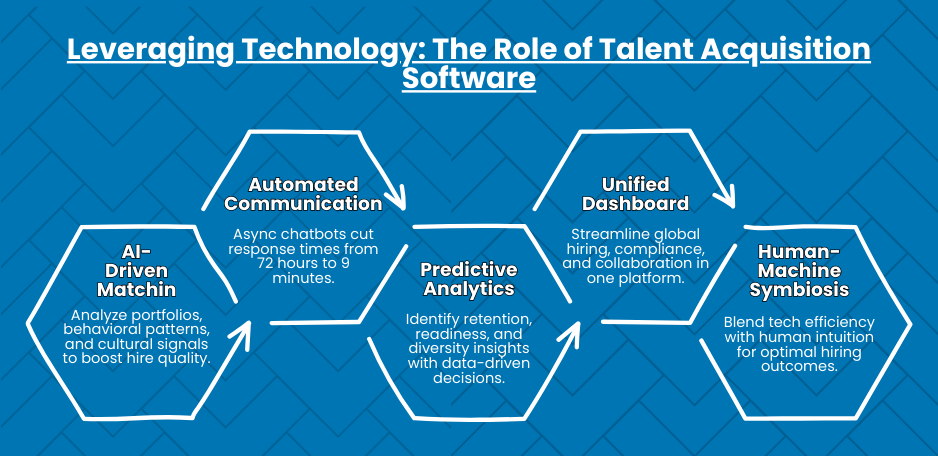
The pandemic-era rush to remote hiring left many lead talent acquisition specialists scrambling—like chefs trying to boil water without pots. Enter talent acquisition software: the digital kitchen revolutionizing how we source, engage, and secure top remote talent. It’s not just about replacing spreadsheets; it’s about transforming recruiters into strategic architects of distributed workforces.
Why Manual Methods Die in Remote Recruitment
Traditional hiring tools crumble under global scale. Imagine screening 2,000 applicants across 12 time zones while your hiring manager naps in Sydney. Legacy systems can’t track WhatsApp follow-ups, decode async interview nuances, or predict which Brazilian developer will thrive in your Berlin-based team.
The stakes? 63% of candidates ghost employers with clunky hiring tech, per a 2024 TalentTech report. But armed with modern talent acquisition software, teams cut time-to-hire by 50% while boosting hire quality. Let’s dissect the game-changers.
Core Features Redefining Remote Hiring
1. AI-Driven Candidate Matching: Precision Over Luck
Gone are keyword-stuffed resume searches. AI now analyzes:
- Project portfolios: GitHub commits, Figma files, or even freelance client reviews
- Behavioral patterns: Does the candidate engage in niche forums? Respond to emails at 2 AM their time?
- Cultural signals: Language subtlety in past team chats or mentorship activities
RecruitBPM Edge: Its algorithm cross-references candidates’ digital footprints with team success metrics. One media company found a writer via her Substack comments—her snarky yet constructive tone matched their top-performing editors.
2. Automated Communication: Async at Scale
Time zones are remote recruitment’s silent killers. The solution? Chatbots and email sequences that:
- Send interview reminders based on local holidays
- Adjust messaging tone by region (formal in Japan, emoji-friendly in Canada)
- Nudge passive candidates with personalized project invites
Case Study: A SaaS firm using RecruitBPM’s automation slashed response times from 72 hours to 9 minutes—crucial when racing for niche DevOps talent.
3. Predictive Analytics: From Gut Feel to Hard Numbers
Why guess which hire will stick when data whispers truths? Top talent acquisition software tracks:
- Retention correlation: Candidates who ask about career growth paths stay 2.3x longer
- Remote readiness: Those using project management tools personally are 41% less likely to quit
- Diversity gaps: Real-time alerts if pipeline skews male-heavy or Euro-centric
RecruitBPM: The Swiss Army Knife for Distributed Hiring
While many platforms handle pieces of remote recruitment, RecruitBPM integrates them into one ruthless machine:
- Unified Dashboard: Track a Nairobi candidate’s interview stage, document signings, and even visa status in real-time
- Compliance Guardrails: Auto-flag GDPR mishaps or misclassified contractor risks
- Collaboration Hub: Secure Slack-like threads where hiring teams debate candidates without drowning in CC’d emails
But the real magic? Anticipating needs before they’re voiced. When a lead talent acquisition specialist in Toronto plugged in a sudden need for Ukrainian fintech experts, RecruitBPM:
- Mapped local salary benchmarks adjusted for war-impacted economies
- Identified 57 candidates via niche Crypto Twitter communities
- Generated outreach templates acknowledging the crisis’s sensitivity
Result: 8 hires in 11 days, each receiving tailored relocation support.
The Human-Machine Symbiosis
Even the sharpest talent acquisition software falters without skilled pilots. Here’s how lead talent acquisition specialists elevate tech:
1. Strategic Filtering
AI shortlists 100 candidates? The specialist cherry-picks the 3 with latent leadership traits a bot can’t spot.
2. Emotion Engineering
Automation sends offer letters, but specialists add personalized Loom videos explaining why the hire matters.
3. Ethical Guardianship
When AI inadvertently biases against non-native English writers, human oversight recalibrates the algorithm.
Pitfalls to Sidestep
- Over-automating empathy: Candidates smell robotic outreach. Blend scheduled nudges with spontaneous voice notes.
- Tool overload: RecruitBPM replaces 7+ tools, but some demand niche add-ons (e.g., global payroll integrators)
- Data myopia: Analytics say “hire fast,” but specialists pause to ask: Will this person thrive when the VPN crashes at 3 AM?
Talent acquisition software isn’t replacing specialists—it’s amplifying their superpowers. With RecruitBPM, teams move from reactive scrappiness to predictive prowess. As one lead specialist put it: “It’s like having a co-pilot who handles turbulence while I chart the course.”
In the remote talent wars, the winners aren’t those with the fanciest tech, but those who weld it to human intuition. Because even in 2025, people hire people—just through smarter screens.
Overcoming Challenges in Remote Talent Acquisition
Remote work has shattered geographical barriers—but for Talent Acquisition Specialists, it’s also forged new battlegrounds. The very tools that enable global hiring create hurdles even seasoned pros underestimate. From decoding virtual charisma to untangling time zone wars, here’s how to conquer the top three remote recruitment nightmares.
Challenge 1: Assessing “Fit” Through a Screen
The Problem: How do you gauge a candidate’s problem-solving grit or team chemistry without sharing a room? For clinical talent acquisition specialists, this is existential. A nurse might ace clinical simulations but crumble under remote patient monitoring pressures.
Solutions:
- Virtual Role Plays: Simulate high-stakes scenarios. For clinical roles, test responses to emergency calls with poor connectivity or EHR system crashes.
- Asynchronous Skill Journals: Have candidates document a week of self-directed learning (e.g., mastering a new telehealth platform). Patterns reveal initiative.
-
Culture Fit Bingo: Create a checklist of subtle indicators:
- Do they ask about peer support systems?
- How do they talk about past mistakes? (“My team failed” vs. “I couldn’t convince them”)
Case Study: A hospital system hired a remote psychiatric nurse practitioner after she diagnosed a mock patient’s crisis while her toddler screamed off-camera—proving grace under fire.
Challenge 2: Timezone Jiu-Jitsu
The Problem: Scheduling a three-stage interview across New York, Nairobi, and Kuala Lumpur isn’t just logistics—it’s geopolitical Tetris.
Solutions:
- Reverse Scheduling: Let candidates pick windows (e.g., “I’m free 6-9 PM GMT+8”) via Calendly, then lock the most inclusive slot.
- Async Panels: Replace live group interviews with pre-recorded stakeholder questions. Candidates respond via Loom within 48 hours.
- Timezone Equity Audits: Track whose zones always get “off-hours” slots. Adjust rotationally.
Pro Tip: For clinical talent acquisition specialists, align shifts with candidates’ home-region demand. A Philippines-based night nurse might prefer U.S. hours if it aligns with local job scarcity.
Challenge 3: The Loneliness Factor
The Problem: Remote hires quit over isolation, not incompetence. A 2024 Mental Health America study found 52% of remote clinical staff feel disconnected from peers—a retention time bomb.
Solutions:
- Pre-boarding “Buddy” Pairing: Connect hires with tenured employees 2 weeks pre-start for non-work chats (shared hobbies > shop talk).
- Virtual Watercoolers: Mandate camera-off casual channels (e.g., Slack #pet-parade) to mimic office banter without Zoom fatigue.
- Wellness Vetting: Ask candidates, “How do you recharge after tough days?” Listen for sustainable habits vs. martyr complexes.
Clinical Hiring’s Unique Tightrope
For clinical talent acquisition specialists, remote hiring demands extra rigor:
-
Credential Quicksand:
- Verify licenses not just for current states, but reciprocity agreements. A Texas RN can’t treat California patients remotely without compacts.
- Use blockchain-verified credential platforms like ProCredEx for instant validation.
-
Tech Literacy Sniff Tests:
- Example: “Walk me through your last telehealth visit. Where did you click first in the EHR?”
- Watch for workflow hacks, like using dual monitors or voice-to-text macros.
-
Empathy at Scale:
- Deploy AI sentiment analysis on candidate emails to flag burnout risks (e.g., recurring frustration phrases).
The Remote Resilience Mindset
Overcoming these hurdles isn’t about tools—it’s cultivating adaptability. The best Talent Acquisition Specialists:
- Pre-Game Worst Cases: Role-play candidate Wi-Fi failures or power outages during interviews.
- Bias-Check Their Bots: Audit AI screening tools monthly for ableist or cultural blindspots.
- Track What Truly Matters: Ditch “time-per-hire” for metrics like “90-day mentor satisfaction scores.”
A clinical talent acquisition specialist in Miami shared her mantra: “I don’t hire clinicians. I hire humans who can heal through screens.” Nail that balance, and remote barriers become bridges to untapped talent.
Final Thoughts
The remote recruitment revolution isn’t looming—it’s here. Talent Acquisition Specialists who cling to yesterday’s playbooks risk irrelevance, while those embracing agility and innovation will dominate the borderless talent wars. From decoding digital body language to orchestrating global hiring symphonies, success hinges on one truth: Remote isn’t a location—it’s a mindset.
The stakes? Companies slow to adapt, hemorrhage top talent to rivals offering seamless virtual experiences. Yet those leveraging tools like RecruitBPM transform chaos into strategy, replacing manual grunt work with AI-precision and data-driven insights. Imagine slashing mis-hires by 45% while nurturing pipelines richer and deeper than ever.
Your Move
- Newcomers: Start small. Audit one process—sourcing, screening, onboarding—and pressure-test its remote readiness.
- Veterans: Level up. RecruitBPM’s analytics uncover patterns invisible to the naked eye (e.g., why Eastern European engineers thrive in your APAC teams).
- Leaders: Future-proof. Align talent strategies not just with today’s needs, but 2028’s unknowns.
The question isn’t if you’ll adopt tools like RecruitBPM, but when. Every delay costs talent, trust, and competitive edge. Ready to stop chasing and start leading?
Act Now
- Explore RecruitBPM’s free demo—see how 17 global enterprises cut remote hiring costs by 30% in 6 months.
- Rethink one legacy process this week: Swap resume screens for skills challenges.
- Join the vanguard: Become the Talent Acquisition Specialist peers quote, not chase.
The future of work won’t wait. Will you?
FAQs
How has remote work fundamentally changed the role of a Talent Acquisition Specialist?
Remote work has shifted focus from local networking to global talent arbitrage. Talent Acquisition Specialists now prioritize skills like virtual candidate engagement, cross-cultural competency, and AI-augmented sourcing. Tools like RecruitBPM have become essential, automating tasks like cross-border compliance checks and predictive candidate matching.
Can traditional hiring methods work for remote roles?
Barely. Resume reviews miss remote-ready traits (e.g., async communication), while in-person interviews fail to simulate distributed work realities. Modern talent acquisition requires behavioral simulations, skills-based assessments, and data-backed candidate rediscovery—areas where manual processes crumble.
What’s the biggest mistake companies make in remote recruitment?
Misjudging “remote experience” as generic. A candidate excelling at freelance gigs may flounder in structured remote teams. Specialists using platforms like RecruitBPM pinpoint candidates who thrive in your workflows via customized remote-readiness audits.
How do we assess company culture fit without in-person interaction?
- Conduct virtual “day-in-the-life” simulations using tools like Gatheround
- Analyze candidates’ past remote work artifacts (e.g., Slack thread etiquette)
- Use RecruitBPM’s culture alignment scoring, which benchmarks traits against top performers
Why invest in talent acquisition software like RecruitBPM vs. free tools?
Free tools handle tasks; paid platforms solve problems. RecruitBPM offers:
- AI-driven candidate matching across global databases
- Automated compliance checks for 100+ countries
- Predictive attrition risk scoring
- Async interview analytics (e.g., speech patterns correlating with remote success)
How can we manage time zone chaos in global hiring?
- Use RecruitBPM’s smart scheduling to auto-detect overlapping availability
- Implement a “follow-the-sun” hiring panel (e.g., AMER/EMEA/APAC reviewers)
- Set core hours for live interactions, leaning on async video assessments
What remote hiring metrics actually matter?
Ditch “time-to-fill.” Track:
- 90-day retention rates for remote hires
- Productivity ramp-up speed vs. onsite peers
- Candidate net promoter score (NPS) post-virtual interviews
How do we combat candidate ghosting in remote recruitment?
- Personalize automated updates via RecruitBPM’s dynamic templates (e.g., “Hey [Name], your Python test blew us away—update coming Thursday!”)
- Assign a dedicated “candidate concierge” for high-priority prospects
- Conduct exit surveys with ghosters to identify process pain points
Can SMEs compete with corporations in remote talent wars?
Absolutely. Talent Acquisition Specialists at SMEs use agility as leverage:
- Highlight niche impact (“You’ll shape our AI roadmap from day one”)
- Offer radical flexibility (4-day workweeks, project-based contracts)
- Use RecruitBPM to mimic enterprise-grade hiring at startup costs
What’s the first step to overhauling our remote recruitment strategy?
Audit one bottleneck (e.g., sourcing, screening) and pilot RecruitBPM’s corresponding module. Most teams see a 30% efficiency gain in 60 days—enough to fund further transformation.





